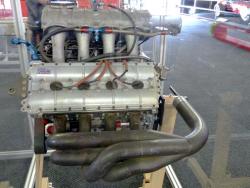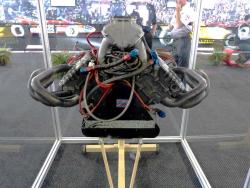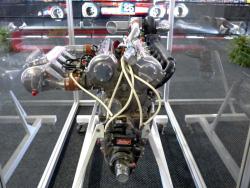   Historical examples of IndyCar engines on display at Honda World. Click image to enlarge |
Six years, 101 races. That’s how long Honda went without a single engine failure during their stint as the sole engine supplier to the IndyCar series from 2006-2011. 101 races: that shakes out to more than 600,000 km at racing speeds without throwing a rod, spinning a flywheel or detonating a valve train.
Honda achieved that consistency with a naturally aspirated, four-camshaft, 32-valve, 3.5L V8 that produced 650 hp and revved to 10,300 rpm. These were not lazy, detuned teddy bear engines, these were angry, stressed-out hulks capable of erupting and tearing themselves free of their chassis mounts should they be poked hard enough.
For 2012, Honda had a new challenge. Not only did two new challengers join the fray (Lotus, who departed quickly and in disgrace from the sport, and Chevrolet, who continue to race), but the engine specs changed. Honda now produces a turbocharged, 24-valve, 2.2L V6 rev-limited to 12,000 rpm and producing between 550 and 700 hp – depending on the series regulations for each round.
Wait, what? “Depending on the series regulations”? Yep. IndyCar alters the boost levels for each circuit in the interests of safety. So at Indianapolis for the 500, the car produced just 550hp, while for the shorter street circuits where speeds are lower, IndyCar allows more boost to assist acceleration.
“Boo, hiss,” say the power fiends, “I want 700 hp at Indy.” Cars are allowed to run higher boost during qualifying at the Indy 500 and regularly post average speeds of more than 360 km/h (225 mph). Those sorts of average speeds are simply too high for race day. Honda engineers have estimated they could easily extract more than 1000 hp from these engines. During the heyday of North American open-wheel racing in the 1990s, Honda’s CART teams were getting well over 900 hp from the engines.
In fact, during the late 1990s when CART and IRL were still at war, Gil de Ferran recorded the fastest lap speed of all time: an average speed of 388.537 km/h (241.426 mph) at the 3.22 km (two mile) Auto Club Speedway in Fontana, California. At those speeds the g-forces were so high some drivers began to black out and become disorientated. That’s not ideal when the only thing between you and 100,000 fans is a small carbon-fibre chassis and a heavy concrete fence.
    2013 Honda Indy. Click image to enlarge |
But enough about Occupational Health and Safety: Let’s talk about Honda’s engine program.
Currently Honda supplies engines to 14 full-time entrants in the 2013 IndyCar season. They supply each car with its own trackside engineers, plus take their own team of senior engine engineers to each race. At the Honda Indy Toronto there are 17 trackside engineers operating. Those engineers are tasked with tuning the cars to the unique conditions of the day.
For example, Friday’s qualifying session was conducted in 21-degree Celsius heat; Saturday and Sunday are expected to be 24 and 30 degrees respectively. That jump in ambient temperature has a significant effect on engine performance.
Added to that, the cars will perform a series-first standing start for Saturday’s race (the first time many drivers will have attempted a standing start for over a decade), and then a traditional rolling start on Sunday.
|
Related Articles: Auto Tech: Audi Tron Future Lab Experience, R18 e-tron Quattro and R8 e-tron Related Websites: Photo Gallery: |
The changes in the start procedures will tax the engines in different ways, and without launch control or traction control to tame the 700 wild horses under the cowling there is plenty of opportunity to buzz the engine in a spray of wheel spin. The additional challenge of Toronto’s tight track means there is a premium on low-down, point and squirt torque.
Honda opts for a large single turbo on their engines, while Chevrolet prefers to run two smaller turbos. The twin-turbo setup packs a slightly smaller punch, but theoretically comes on earlier. Honda’s setup was optimized for the high-speed Indianapolis 500 and engineers will have their work cut out for them when it comes to maximizing performance on the streets of T.O.
IndyCar is currently Honda’s highest-profile four-wheeled endeavour (they also dominate MotoGP), but all that will change in 2015 when the Japanese marque returns to Formula 1. Regardless of where it occurs, Honda says that the high-pressure, high-intensity stress of competition is what drives their reliability and performance on the road.
Honda Indy Toronto features a new-for-2013 two-race format this weekend. Race one will begin at 3:40 pm on Saturday, July 13.
Race two will kick off at 3:40 pm EST on Sunday, July 14. Both races will be broadcast live on Sportsnet.











